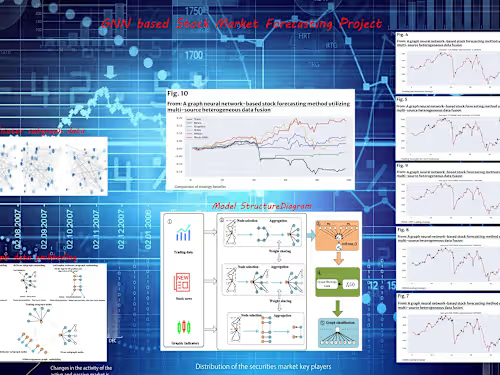
Data Science & Data Analytics & Predictive Analysis
Starting at
$
70
/hrAbout this service
Summary
What's included
Predictive Analytics and Forecasting
Forecasting Models: Predictive models for business outcomes (e.g., sales, customer behavior, market trends). Performance Metrics: Accuracy, RMSE (Root Mean Square Error), MAE (Mean Absolute Error) for forecast precision. Visualization Dashboards: Interactive dashboards showing predicted trends, confidence intervals, and key drivers. Scenario Analysis: “What-if” analysis for understanding different future scenarios based on variable changes. Deployment: Real-time deployment of forecasting models into production systems for automated forecasting.
Customer Segmentation
Segmentation Models: Clustering models such as k-means, DBSCAN, or hierarchical clustering to segment customers. Customer Profiles: Detailed reports on each customer segment, including demographic and behavioral insights. Targeted Campaigns: Segmented marketing strategies for each customer group. Performance Metrics: Segmentation effectiveness, engagement rates, and ROI from targeted campaigns.
Recommendation Systems
Collaborative Filtering: Building recommendation algorithms based on user behavior and preferences. Content-Based Filtering: Recommending items based on similarities to previously liked or purchased items. Hybrid Models: Combining multiple recommendation techniques to increase accuracy. Personalized Recommendation Engine: Real-time product or content recommendations based on user activity. User Engagement: Increased user engagement and conversion rates from personalized experiences.
Churn Prediction
Churn Prediction Models: Machine learning models (e.g., logistic regression, decision trees, or random forests) to predict churn likelihood. Churn Risk Scores: Assign churn risk scores to customers to prioritize retention efforts. Retention Strategies: Automated alerts and tailored retention strategies based on churn prediction outcomes. Key Performance Indicators: Churn rate reduction, retention rate improvement, and customer engagement metrics.
Sentiment Analysis and Text Mining
Sentiment Detection: Analysis of customer feedback, reviews, and social media data to gauge sentiment (positive, negative, or neutral). Text Classification Models: Custom NLP models to classify and categorize text (e.g., complaints, inquiries, or praise). Sentiment Dashboards: Visualizations of customer sentiment trends over time, including specific events or campaigns. Brand Monitoring: Real-time tracking of brand mentions and public sentiment on social media.
Fraud Detection
Anomaly Detection Models: Using machine learning techniques to detect unusual patterns indicative of fraud. Real-Time Fraud Alerts: Automated alert systems for suspicious transactions or activities. Fraud Risk Scores: Scoring of transactions based on likelihood of fraud. Performance Metrics: Detection accuracy, false positive rate, and time-to-detection.
A/B Testing and Experimentation
Test Design and Setup: Structuring A/B tests, including control and variation groups. Experimentation Reports: Detailed reports on test outcomes, including statistical significance, p-values, and confidence intervals. Optimization Recommendations: Insights and actionable recommendations based on testing results. Continuous Monitoring: Ongoing experimentation and optimization through automated A/B testing pipelines.
Supply Chain Optimization
Demand Forecasting Models: Predict future demand to optimize production and inventory management. Inventory Optimization: Models to minimize overstock and stockouts while optimizing warehouse space. Logistics & Routing Models: Optimized delivery routes and transportation logistics for reduced costs. Risk Management: Forecasting potential supply chain disruptions and recommending mitigation strategies.
Market Basket Analysis
Association Rule Mining: Identify patterns of products frequently bought together using techniques like Apriori or FP-growth. Product Bundle Recommendations: Tailored recommendations for cross-selling and bundle offers. Promotion Optimization: Strategies for maximizing sales through targeted promotions based on item associations. Customer Behavior Insights: Understanding customer purchase behavior to improve product placement.
Time Series Analysis
Trend and Seasonality Analysis: Identifying and forecasting patterns in sequential data. Time Series Forecasting Models: ARIMA, SARIMA, or Prophet models to predict future values based on historical data. Seasonal Adjustment: Adjusting for seasonal variations to provide more accurate predictions. Anomaly Detection: Identifying irregularities or outliers in time-series data.
Risk Assessment and Management
Risk Models: Statistical and machine learning models for identifying and quantifying risks. Risk Scoring: Assigning risk scores to various entities, such as loans, investments, or clients. Real-Time Risk Alerts: Automated alerts for high-risk situations or potential threats. Decision Support: Tools to assist in risk management decisions, including trade-offs between risk and reward.
Natural Language Processing (NLP)
Text Preprocessing: Data cleaning and transformation for better NLP model performance. Named Entity Recognition (NER): Identification of key entities (e.g., person names, locations, products) in text. Text Classification: Classifying text into predefined categories (e.g., spam detection, sentiment analysis). Chatbot Development: AI-driven chatbots for customer service, providing automated responses. Document Summarization: Extracting concise summaries from large volumes of text data.
Skills and tools
Data Modelling Analyst
Data Scientist
Data Analyst
Data Analysis

Microsoft Excel

pandas

PredictLeads

Tableau
Industries
